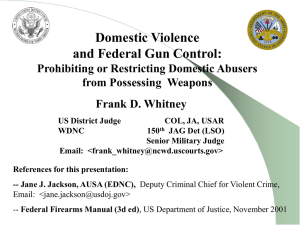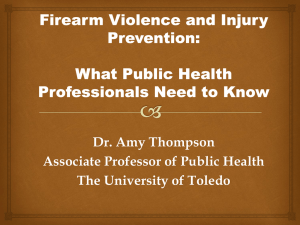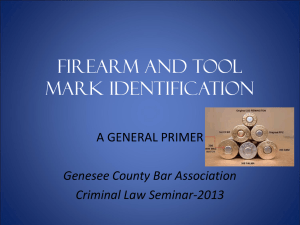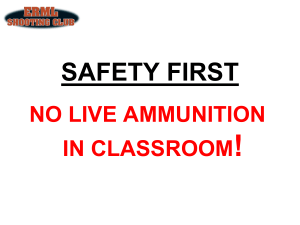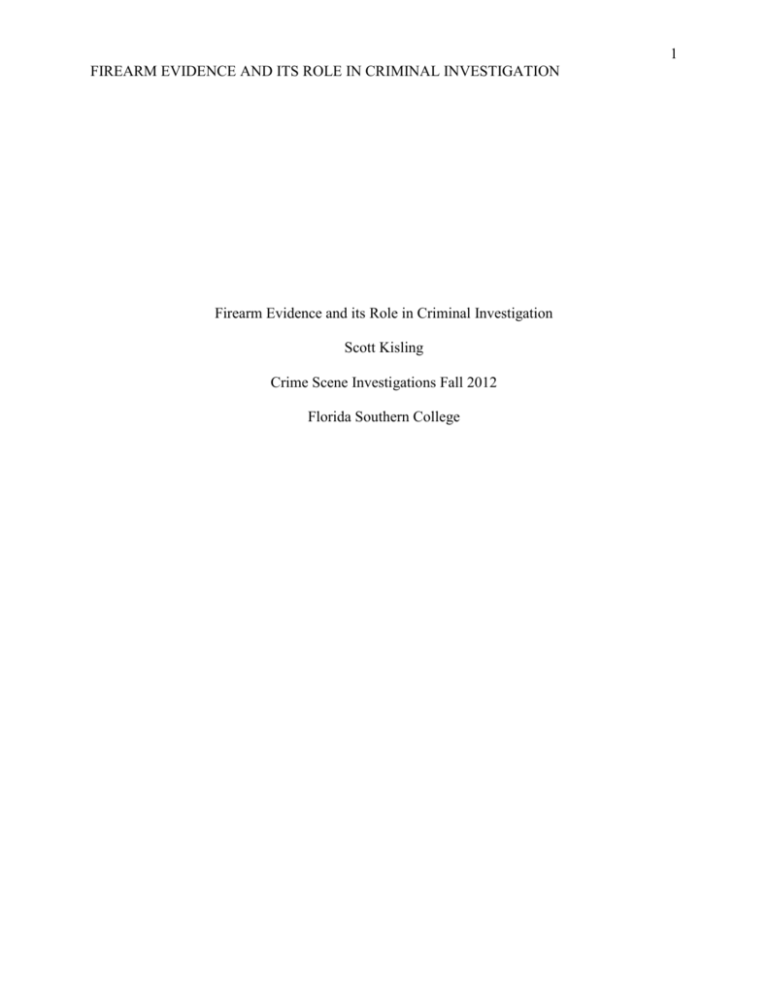
1
FIREARM EVIDENCE AND ITS ROLE IN CRIMINAL INVESTIGATION
Firearm Evidence and its Role in Criminal Investigation
Scott Kisling
Crime Scene Investigations Fall 2012
Florida Southern College
2
FIREARM EVIDENCE AND ITS ROLE IN CRIMINAL INVESTIGATION
Firearm Evidence and its Role in Criminal Investigation
Criminal investigations heavily rely on the evidence collected from the crime scene to
solve a case. Crime scenes contain a multitude of types of evidence; one such type of evidence
includes firearms. Firearm evidence has a particularly important role in forensic investigations,
because the use of such weapons is common in many crimes against persons, such as homicide,
assault, robbery; however, firearms use may also be present in crimes like burglary, rape, and
narcotics transactions or in violent activity between gang members (California Department of
Justice, 1984).
According to the National Institute of Justice, in 2005 nearly 11,346 persons were killed
by firearms and 477,040 were the victims of a crime involving the use of a firearm While the rate
of firearm violence in nonfatal crimes has declined from 11% to 9% from 1994 to 2005, the rate
of homicides by firearm has risen from 60% to 77% from 1976 to 2005 (Department of Justice,
2010). Evidence obtained from firearms can be an effective and critical mechanism in the
investigation of numerous crimes. Given the severity and prevalence of crimes which encompass
the use of firearm, one can conclude that proper protocols for obtaining firearms, technological
advances, and firearm evidence analysis embody a central role in concluding numerous criminal
investigations.
Firearm evidence allows investigators to reconstruct a crime scene, the sequence of
events of the crime. When investigating crimes involving firearms, the utilization of ballistics
examines the dynamics of projectiles and bullet trajectory to reconstruct the crime. Firearm
evidence also has special circumstances in which projectiles and cartridge casings can provide
critical evidence about the crime. If evidence is not properly collected, recorded, and analyzed,
this could have negative implications for the direction of the investigation.
3
FIREARM EVIDENCE AND ITS ROLE IN CRIMINAL INVESTIGATION
First, it is important for an investigator to have an extensive knowledge about the
different types of firearms, before any evidence and conclusions can be made about the weapon
as evidence in a criminal investigation. Each type of firearm has unique qualities, which have
important implications in understanding the sequence of the events of the crime. With each type
of firearm, there are specific requirements for collecting each item and preserving the physical
evidence associated with the weapon. The major categories of firearms include: shoulder
firearms, semi-automatic pistols, and revolvers.
Shoulder firearms are characterized as single-action, semiautomatic or fully automatic
rifles and shotguns (Young and Ortmeier, 2011). Semiautomatic rifles and shot guns dispense
cartridges automatically upon releasing the trigger. As defined by the Bureau of Alcohol,
Tobacco, Firearms and Explosives (ATF) of the United States government, a shoulder firearm
(termed “rifle”) is a weapon designed or redesigned to be fired from the shoulder in a single-fire
action, where a single explosive cartridge is released for each single pull of the trigger (2011).
The size and caliber of rifle ammunition differ between each shoulder firearm, and the
cartridge casings and bullets are similar to that of handguns as seen in the tool mark and barrel
rifling evidence. In contrast, to the barrel of a rifle interior surface of the shotgun is smooth and
differs from a rifle in its grooves, lands, and striations. A shotgun shell encompasses small, lead
pellets with gunpowder and a metal base, where one can identify the firing pin (Young and
Ortmeier, 2011).
Semiautomatic pistols automatically fire a bullet, with the immediate reload of
ammunition cartridge upon pulling the trigger. In semiautomatic pistols, it is important for an
investigator to consider the rifling of the weapon. Rifling of a semiautomatic pistol is the grooves
in the barrel, which are engraved during manufacturing (the areas not cut in the barrel are the
4
FIREARM EVIDENCE AND ITS ROLE IN CRIMINAL INVESTIGATION
lands). The rifling of this type of weapon allows the bullet to spin, which increases the success of
accuracy in the trajectory of the bullet (Young and Ortmeier, 2011).
The third and final major classification of firearms is the revolver. The revolver is
characterized as a handgun possessing rotating cartridges and cylinders. Revolvers have two
variations: either single-action or double-action. The single-action revolver involves cocking the
handgun by its hammer. The double-action revolver can be cocked either in the same mode as
the single-action revolver or through simply pulling the trigger. Young and Ortmeier describe he
double-action mode, however, is more time consuming and requires a more profound trigger pull
than utilizing the single-action mode (2011).
Characteristically, revolvers enclose five to nine cartridges which vary with the producer
and model. Revolvers are similar to semiautomatic pistols in that their barrels are rifled, with
similar lands, grooves, and striation markings. In the manufacturing process, a striation is a fine
scratch fabricated by an imperfection created in the barrel of the rifled barrel of the firearm.
Unlike semiautomatic pistols, revolvers’ expended cartridges are not simultaneously dispensed
upon the projection of the bullet (Young and Ortmeier, 2011).
In order for firearm evidence to effectively guide the criminal investigation, it must be
collected following a strict protocol. If strict measures are not observed in obtaining the
evidence, important information regarding the case can lost if the evidence is contaminated.
Although there is a great emphasis on preserving all physical evidence contained on or within the
firearm, the concern for safety is the most important protocol in beginning any collection and
analysis of the firearm in the investigation of a crime scene. In all cases where a firearm is
present as evidence, the weapon should be considered loaded. Prior to collecting any firearms for
5
FIREARM EVIDENCE AND ITS ROLE IN CRIMINAL INVESTIGATION
analysis in a forensic laboratory, the firearm must be immediately rendered safe, which will
depend on the mechanisms of the weapon.
The forensic technician collecting evidence from the firearm should feel comfortable and
be familiar with unloading the firearm; in order for such technicians to be effective in working
with firearm evidence, it is highly recommended that that they complete a firearms safety course
under the agency’s firearms expert or range master to acquire information regarding safety
protocol. In the event, however, that the forensic technician is uncomfortable in working with the
firearm, a firearm expert, firearms range master, or experienced and knowledgeable officer may
render the firearm safe at the crime scene.
Once a firearm is rendered safe, the forensic technician should assign an evidence
number to the weapon. Preceding collection of the firearm into a laboratory, the technician must
photograph the orientation of the firearm, and photograph close-up views. Following these
photographs, the evidence must be marked with a marker, and photographs must also be taken of
the firearm with the placement of these markers.
In the instance of obtaining a shoulder firearm, a technician should collect the firearm by
holding the grip or the stock; they should circumvent handling or contacting the smooth surfaces
of the weapon, as this may contaminate the evidence with fingerprints. In accordance with safety
protocols, a shoulder firearm should be clasped at the grip or stock must be pointed downward
and away from any other persons present at the crime scene. An item may never be placed inside
the barrel to pick up the shoulder firearm, because this can scratch the barrel and contaminate
trace or DNA evidence. In consideration for the especially large size of shoulder firearms,
photographs must be taken of the orientation and close-up views of the firearm’s placement
(Young and Ortmeier, 2011).
6
FIREARM EVIDENCE AND ITS ROLE IN CRIMINAL INVESTIGATION
Specialized protocol for obtaining a semiautomatic pistol first involves rendering the
firearm safe, where the forensic technician wears latex or vinyl gloves and unloads the pistol.
When unloading the pistol, it should be held at the grip and pointed downward (away from any
surrounding persons), and the technician must be mindful to prevent contact with any of the
smooth surfaces. Next, the magazine button should be released and the magazine should be
secured within a paper bag or a specialized firearms container. In the event that the pistol’s slide
is previously pulled back, before the removal of the magazine, there will be a new chambered
cartridge. The pistol in this case will be considered loaded.
On the other hand, in the case that the pistol’s slide is not previously pulled, it should be
pulled back to remove a cartridge, which may still be present in the chamber. Once removed, a
cartridge should be sealed in a coin envelope or pillbox for further analysis. In both scenarios,
whether the slide is pulled or not, the technician must first always dislodge the magazine. The
investigator should then ensure that there are no remnant cartridges. Once this is determined, the
technician should place a plastic zip-tie through the slide opening, placing the firearm in a
specialized box or paper bag. Throughout each stage, the magazine, cartridge, and firearm
containers should be properly marked for later identification in the laboratory analysis.
The primary protocol in obtaining the revolver for further analysis is primarily similar to
the protocols in shoulder firearms and semiautomatic pistols. Safety is the primary concern,
followed by the preservation of physical evidence. The technician should clutch the grip and
point the gun downward and away from surrounding persons, while not disturbing any potential
evidence of latent finger prints through avoidance of touching any smooth surfaces. The unique
protocol for obtaining a revolver begins with marking a small line on the cylinder on either side
of the revolvers’ top strap; marking a line on the cylinder will have an important role in
7
FIREARM EVIDENCE AND ITS ROLE IN CRIMINAL INVESTIGATION
laboratory examination, because it will permit the forensic technician can return the rotating
cylinder in its original position. This line is preferably drawn using a fine tip, black permanent
marker.
With caution, the cylinder release button should then be pressed to open the cylinder,
followed by pressing the cartridge release ejector so that each cartridge can then be removed.
Removal of cartridges should occur in a clockwise manner, and each cartridge should properly
be removed following the sequence of their placement. The forensic technician must be cautious
and mindful when labeling each of the cartridges, with the cartridge in line with the barrel as
labeled number one, and the sequential clockwise cartridges being named in the remaining order.
A diagram of the cylinder should be drawn with the correct number of cartridge holes,
and each hole should be labeled to indicate which cartridge the drawing represents. Cartridges
are then to be enclosed in coin envelopes or pill boxes with each package properly marked for
later identification. A plastic zip-tie should be positioned in the revolver frame, which will then
ensure that the revolver is rendered safe. Similar to obtaining the other major types of firearms,
the revolver should be securely preserved and stored in either a paper bag or specialized firearm
container.
Following the photography of the weapon, a technician or investigator must capture
measurements of the firearm’s location and size. An investigator should sketch the area of the
location in which each item of evidence is collected. Records of the serial number, make, model,
and caliber of the weapon should be marked in an inconspicuous matter, which will not detract
from the value of the evidence (California Department of Justice, 1984).
Properly recording the serial number of a firearm is especially critical in forensic
investigations, because there are instances in which duplicate serial numbers may be found on
8
FIREARM EVIDENCE AND ITS ROLE IN CRIMINAL INVESTIGATION
different firearms of the same make and general type. It is important that the firearm technician
or investigator does not confuse model numbers or patent numbers with serial numbers.
Confusing numbers can potentially contaminate the evidence, and misplace this important
evidence throughout the investigation.
An extensive knowledge of firearms and collection of evidence is not sufficient for
solving crimes; those involved in law enforcement should be able to apply this knowledge and
critically evaluate the unknown of a case, against what is known about certain evidence. In the
case of firearms, this application of knowledge involves extensive background knowledge of
each type of firearm, and how to connect the remnants of a crime such as trajectory or gunshot
residue.
Understanding the unique dynamics and characteristics to each of the three
classifications of firearms provides forensic investigators with information about the crime,
characteristics of the firearm, and can have a critical role in developing an investigation in the
absence of a firearm’s presence at the crime scene through extensive knowledge about the
remnants of each of the three types. One such evidence provided by a firearm is the analysis of
ballistics and trajectory of the projectiles.
Identifying firearms through forensic evaluations of ballistics has made a positive impact
in the investigation of crimes involving firearms. Critical thinking in forensic investigators has
allowed police departments to reconstruct the sequence of events of a crime and link the
evidence to a particular firearm. According to Ghani et. al, this connection is as unique as
identifying a finger print found at a crime scene to a particular individual (2010). No two
firearms are exactly the same, even when they are the same make or model.
9
FIREARM EVIDENCE AND ITS ROLE IN CRIMINAL INVESTIGATION
Projectiles and cartridge cases are critical in instances where a weapon is not present with
the scene of the crime, because they supply information about the type of firearm used in the
case, and can then be linked to a firearm through various data bases. If the evidence is embedded,
it is critical that the forensic technician or investigator does not attempt to remove the projectile
from the surface; rather the portion of the surface should be removed from the scene and brought
as a whole to the laboratory. Attempts to remove projectiles can contaminate evidence through
ruining striations.
With rapidly changing technology, those working in forensic investigations sought to
create a time and resource efficient method for utilizing the evidence gathered from firearms in a
crime in criminal investigations. In 1999, the United States, the Bureau of Alcohol, Tobacco,
Firearms and Explosives in conjunction with the FBI, collaborated to create the National
Integrated Ballistics Information Network (NIBIN). The primary focus of this organization is
partnering with the Integrated Ballistic Identification Systems to obtain digital images of the
markings found on expended projectiles, which will then be compared to previous entries within
the network (National Integrated Ballistic Information Network, 2012).
Developing a network which can provide a forensic investigator or technician with access
to nationwide evidence in firearms increases the chance for successfully linking the evidence of a
crime to a perpetrator. Understanding the unique qualities that present a “forensic fingerprint,”
has advanced law enforcement’s ability to connect crimes spanning the entire country. The
availability and speed at which law enforcement agencies can communicate and find matches
between the evidence of their cases is crucial, considering the number of persons each year who
are either victims or lose their lives to firearm violence.
10
FIREARM EVIDENCE AND ITS ROLE IN CRIMINAL INVESTIGATION
In essence, the National Integrated Ballistic Information Network serves to increase the
number of firearms cases solved, while reducing time and energy expenditure through the
collaboration of departments and advances in technology. The system demands that evidence be
entered into the network, as the rate of evidence provided to the network positively correlates
with successful matching in evidence. Information regarding firearm crimes is becomes more
readily accessible as the amount of information increases (also increasing the likelihood for a
match). Ultimately, this database may serve reduce violent firearm crime, because departments
can identify a larger number of cases at a quicker rate than in previous years, while increasing
the likelihood a perpetrator will be caught and prevented from committing future acts.
Multiple jurisdictions have shown success in the utilization of this network to solve
crimes. These success stories include both local or state police departments within close
proximity to one another and departments separated by more than one state. For example, on
April 16, 2008, police in Wilmington, Delaware investigated a homicide involving a firearm,
where the victim was found on the neighborhood sidewalk.
That same day, two suspects were arrested for a minor traffic violation in New Castle
County, Delaware. The two suspects were found possessing a .32 caliber firearm; they were
arrested for the unlawful possession of a firearm. The Forensic Firearms Service United of the
Delaware police was able to utilize the rapid and ready access to the National Integrated
Ballistics Information Network to connect the .32 caliber found in the suspects’ car with the
evidence found at the murder scene earlier that day in Wilmington (National Integrated Ballistics
Network, 2012).
Without the connection of the evidence in the NIBIN database, what other resource could
have possibly connected suspects who were stopped for what seemed to be a traffic violation
11
FIREARM EVIDENCE AND ITS ROLE IN CRIMINAL INVESTIGATION
with a murder which occurred previously that day? If the database did not exist, is it possible that
instead of serving a 15 year sentence to imprisonment that these defendants would still be free
and remain a potential threat to others?
Without the NIBIN database, even if the two traffic violation suspects caught in New
Castle County were to be arrested for their unlawful possession of a weapon, the likelihood that
they would have been connected to a murder in Wilmington would have been greatly reduced.
Without the database, making the connection to the murder would have required a greater
amount of time to link the cases, and would have demanded more resources on already heavily
consumed law enforcement members and police departments. The ability of the NIBIN to make
quick connections between the police departments based off firearm evidence, liberated time and
resources so that both police departments could also focus their expenditure in other areas of
importance.
Firearm knowledge also plays a significant role in analyzing gunshot residue; gunshot
residue is the unburned gunpowder released from the firearm at the time of firing. Gunshot
residue is also an imperative factor in forensic investigations involving firearms. Anywhere that
gunshot residue is found in a crime scene, indicates that a shooting occurred in a relatively close
proximity. Gunshot residue does not necessarily reside within the firearm, but can be found on
the perpetrator’s body, the victim, and surrounding areas.
Concentration and arrangement are two of the most significant factors in reconstructing
the sequence of events of the crime. For example, if gunpowder residue is found on the shooter’s
hands, then there is a significant likelihood, that person in question fired the weapon. The
distance determination calculates an approximation of the proximity of a shooter to a victim at
the time of the discharge.
12
FIREARM EVIDENCE AND ITS ROLE IN CRIMINAL INVESTIGATION
Concentration is essential in determining the type and caliber of the firearm.
Concentration of gunshot residue varies with differences in concentration and caliber between
the three major classifications of firearms. Taking the arrangement and concentration of the
residue, investigators can reconstruct the distance of the shooting by performing test shootings
on similar types of fabric or materials found at the crime scene. When forensic investigators can
identify a match, this data will be able to provide further information about the crime and
possibly find a match in firearms from the NIBIN.
The distance determination is not only important in discovering the type of weapon used,
but differentiating between a murder and a suicide. As previously mentioned, when the gunshot
residue is found in large concentrations on a suspect’s hands, it is likely they discharged the
firearm. In the event that the discharge was not a homicide, forensic investigators can apply the
same principle to a victim to determine whether they could have pulled the trigger, which ended
their life (Young and Ortmeier, 2011). If the concentrations indicated that the distance between
the victim and the discharge of the weapon was too significant for the victim to have pulled the
trigger, then an investigation can change direction from a suicide to a homicide.
Firearms are utilized in numerous crimes against persons each year in the United States,
and firearm evidence becomes a critical factor in solving these cases. This evidence allows
forensic investigators to reconstruct the sequence of events of the crime; this evidence can also
have important implications when the weapon is not present in the crime scene. Firearm
evidence not only includes the weapon itself, but the remnants of the discharge of the weapon,
and these remnants can allow police departments and forensic investigators to connect multiple
crimes from a single weapon. The development of databases such as the National Integrated
Ballistics Information system has contributed much success to solving crimes involving firearms.
13
FIREARM EVIDENCE AND ITS ROLE IN CRIMINAL INVESTIGATION
When examining the severity and vast number of cases in which a firearm is utilized, the
investigation of the case heavily depends on the knowledge of the types of firearms, how to
properly obtain firearm evidence and how to critically apply this evidence with technology and
laboratory analysis.
References
14
FIREARM EVIDENCE AND ITS ROLE IN CRIMINAL INVESTIGATION
Bureau of Alcohol, Tobacco, Firearms and Explosives. (2011, July 25). Department of Justice.
Retrieved from http://www.atf.gov/regulations-rulings/rulings/atf-rulings/atf-ruling2011-4.pdf
California Department of Justice. (1984). California Department of Justice. Retrieved from
http://www.crime-scene-investigator.net/CAfirearms.pdf
Department of Justice. (2010, October 26). Department of Justice. Retrieved from
http://www.nij.gov/topics/crime/gun-violence/welcome.htm
Md, G. N. A., Liong, C. Y., Jemain, A. A., & The 47th International Conference of the
International Association of Forensic Toxicologists (TIAFT). (May 20, 2010). Analysis
of geometric moments as features for firearm identification. Forensic Science
International, 198, 143-149.
National Integrated Ballistics Information Network. (2012). Department of Justice. Retrieved
from http://www.nibin.gov/
Young, T., & Ortmeier, P. J. (2011). Crime scene investigation: The forensic technician's field
manual. Upper Saddle River, N.J: Pearson/Prentice Hall.




